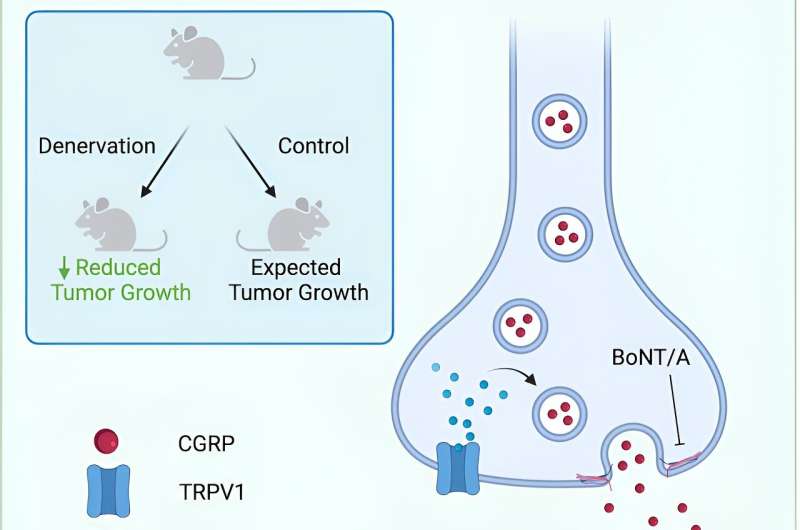This article has been reviewed according to Science X's editorial process and policies. Editors have highlighted the following attributes while ensuring the content's credibility:
fact-checked
peer-reviewed publication
trusted source
proofread
Sensory nerves appear to drive head and neck cancer growth

Researchers at the University of Colorado Anschutz Medical Campus studying interactions between nerves and tumor microenvironments have found that commonly used drugs like botox may stop or slow the progression of certain head and neck cancers.
The study, published online today in the journal Med, examined how nerves within the tumor environment impact the immune system and cancer growth.
"We have long known that the intensity of nerve interactions within the tumor microenvironment are associated with worse outcomes in head and neck squamous cell carcinoma," said the study's lead author Laurel Darragh, an MD/Ph.D. student focused on radiation oncology at the University of Colorado School of Medicine. "This prompted us to investigate how these nerve interactions impact the adaptive immune system and tumor growth."
Using RNA sequencing analysis from human tumor tissue, the researchers found that sensory nerves helped accelerate tumor growth by acting on the immune system to decrease specific T-cells, which fight disease, within the tumor microenvironment.
These sensory nerves released a protein called calcitonin gene-related peptide that directly inhibited these immune cells in the tumor environment. But when researchers blocked the nerves surgically, genetically, or through the use of drugs, they increased T-cell activity and stopped the progression of the cancer for about six weeks.
FDA-approved drugs that block nerve activity, like gabapentin and botox, were found to be especially effective when used in conjunction with radiation treatment.
"The idea that nerves affect the immune make-up of the tumor environment is remarkable," said the study's senior author, Sana Karam, MD, Ph.D., professor of radiation oncology at the CU School of Medicine and member of the CU Cancer Center. "I was surprised to see the botox data—simply stopping the function of a nerve can stop the growth of a tumor."
They found that gabapentin, commonly prescribed for nerve pain, had a similar effect when directly applied directly to nerves in the tumor environment.
Karam said these therapeutics might have synergistic effects with radiation and potentially lower toxicities than currently available treatment regimens.
"To our knowledge, this is the first study to show in depth how sensory nerves are suppressing adaptive immune cells within the head and neck squamous cell carcinoma tumor microenvironment using surgical, genetic, and pharmacologic methods in the context of radiation treatment," the study said.
Karam said the findings indicate that sensory nerves are likely promoting tumor growth by directly influencing the adaptive immune system.
"We want to get to the bottom of the mechanisms behind this so we can develop better therapeutics for patients who cannot tolerate chemotherapy or radiation," Karam said. "We are looking at nerves firing and seeing how we can block them at the terminal end and investigate how that affects cancer growth,"
Darragh said the findings open the door to a novel way of targeting tumors with existing and new drugs.
"I think we are just skimming the surface of what nerves are doing in the tumor microenvironment," she said. "Head and neck cancer is becoming a major problem, so anything we can do to cure or improve the lives of our patients is a major step forward. I think this research gets us closer to that goal."
More information: Laurel B. Darragh et al, Sensory nerve release of CGRP increases tumor growth in HNSCC by suppressing TILs, Med (2024). DOI: 10.1016/j.medj.2024.02.002




















